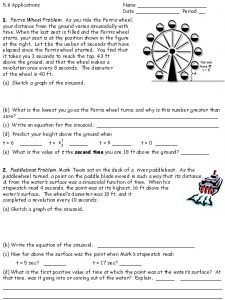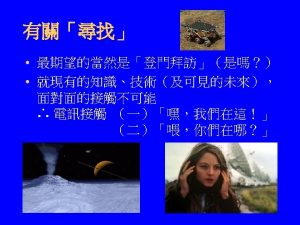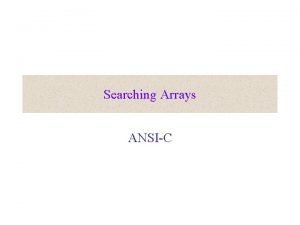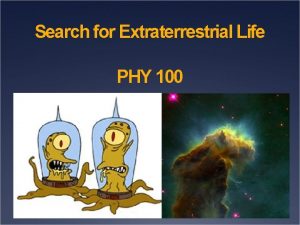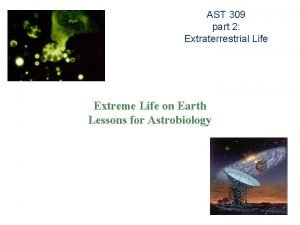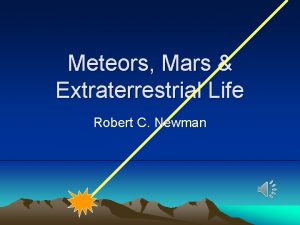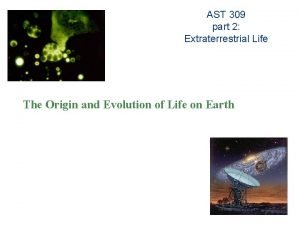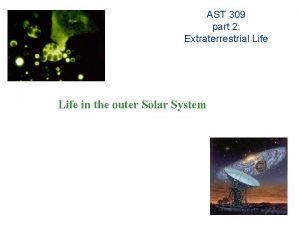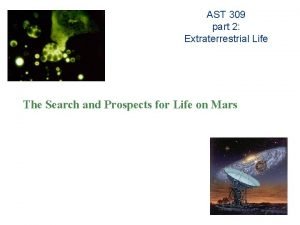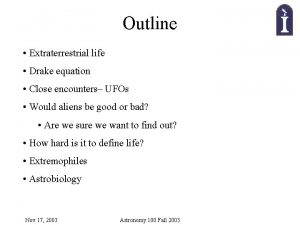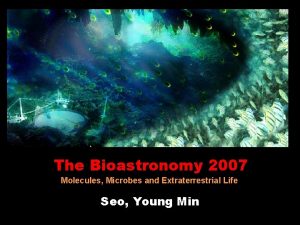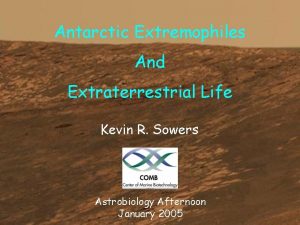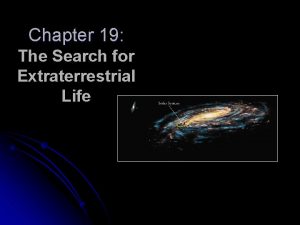Life around us Searching for extraterrestrial life is































![5 G-2[3] Vostok borehole 3425 3424 m – Uppermost frozen water ice 3429 35 5 G-2[3] Vostok borehole 3425 3424 m – Uppermost frozen water ice 3429 35](https://slidetodoc.com/presentation_image_h2/5927218776138712c1e8ceebe551f4a6/image-32.jpg)







![5 G-2[3] Vostok borehole 3425 3424 m – Uppermost frozen water ice 3429 35 5 G-2[3] Vostok borehole 3425 3424 m – Uppermost frozen water ice 3429 35](https://slidetodoc.com/presentation_image_h2/5927218776138712c1e8ceebe551f4a6/image-40.jpg)



- Slides: 43


Life around us? Searching for extraterrestrial life is one of the aims of astrobiology, and there are several potentially habitable worlds in the Solar System, in addition to Earth. Two of Jupiter’s moons (Ganymede and Europa) and two of Saturn’s moons (Titan and Enceladus) harbour liquid-water oceans. And Mars probably had vast liquid-water environments during much of its early history. Lazcano 2012 Nature 488: 160 -1 Bulat 14 oct-03 Russian Cosmic Day, IKI

Geysers of water vapour shooting from Europa's surface Bulat 14 oct-03 NASA/JPL/Ted Stryk Russian Cosmic Day, IKI K. Retherford/Southwest Research Institute

'Diving' Tectonic Plates on Jupiter's Moon Europa 40 -90 million years old Bulat 14 oct-03 NASA/JPL/Ted Stryk Russian Cosmic Day, IKI K. Retherford/Southwest Research Institute

Large subsurface ocean near Enceladus south pole Bulat 14 oct-03 Russian Cosmic Day, IKI Cassini Imaging Science Subsystem –courtesy NASAJPL-Caltech

Vostok station (+3488 m) (78°S, 106°E) (since dec 1957) 67 k. Pa – 67% oxygen 1260 km from the coast 21 July 1983 Absolute minimum -89. 2°C Average ann. Temp. -55. 1°C RADARSAT, CSA Lake Vostok (-3663 m)

Vostok Surface snow (0 – 130 m up to 4 Kyr ) Below 3 m the snow is pristine Very clean ‘life-hostile’ environ NO FREE (only BOUND) WATER! • Low accumulation – 2. 1 -2. 4 g /cm 2/a • Low Aeolian dust input (6 -6. 5 cm/a – snow / needles!) – 2 μm mode; 18 ppb (Holocene) vs. 730 ppb (LGM) • Harsh irradiation (UV-C etc. ) (‘ozone hole’ – Aug-Nov) – + Water-Oxygen free radicals – Oxidized organics (photochemical reactions at ice-air interface) • Low freezing temperatures – below -36 o. C (-55. 1 o. C ann. ) Bulat 14 oct-03 Russian Cosmic Day, IKI

SALE Subglacial Antarctic Lake Environments - 379 CRYOSPHERE Wright et Siegert , 2012

Lake Vostok Discovery First reported at the 23 rd session of SCAR in Rome in 1994 Published in Nature (Kapitsa et al. , 1996) Bulat 14 oct-03

Subglacial Lake Entry on the Horizon in Antarctica – Subglacial Lake Vostok, the largest known subglacial lake on earth (3769. 3 m-1. 5 km) • Fev 05, 2012 – Russia – Subglacial environments • beneath West Antarctic Whillans ice stream (800 m - 2 m) Jan 27, 2013 – US – Subglacial Lake Ellsworth, • West Antarctica (3200 m 160 m) >2018 - UK Bulat 14 oct-03 Russian Cosmic Day, IKI

WISSARD Subglacial Lake Whillans study site for LISSARD, the grounding zone wedge, study site for RAGES, and GBASE will sample both sites.

Lake Vostok known since 1994 Published in Nature (Kapitsa et al. , 1996) RADARSAT, CSA Friendly environment? FREE (LIQUID) WATER! • • Deeply ice buried (in dark) – 4 km High pressure – 337 -377 bar Permanently BUT not very cold – -2. 65°C Likely oxygen supersaturated - 800 mg/L (upper bound 700 -1300 mg/L) Bulat 14 oct-03 Russian Cosmic Day, IKI

RADARSAT, CSA Lake Vostok settings • Huge subglacial lake (Masolov et al. , SCAR OSC 2008) – 275 x 65 km in size; 15 500 km 2 area; 6 100 km 3 water – Two main basins with the ridge between 150 -200 m deep – Average depth - 300 m; max depth – ~1650 m (south basin) – Water renewal – 80 -100 Kyr 2. 0 -0. 8 Ma years old • Buried beneath 2. 0 -0. 8 Myr old 3750 -4200 m thick ice sheet • Isolated from surface biota for >14 Ma – Age of water (melted ice) - ~1 Ma • No hydrological links to other lakes Bulat 14 oct-03 Russian Cosmic Day, IKI

Vostok ice core 19. 02. 1990 North ~4 km from coast (78°S, 106°E) South 3650 m 0. 8 Ma 2. 0 Ma – 3538 m Accretion Melting zone Gases 680 m Accretion (lake) ice Accr. rate – <10 mm/a

Vostok borehole-frozen water ice core

Cold room at LGGE Bulat 14 oct-03

Fine snow/ice dust particles et DNA analyses DNA/RNA Bio. Cap hood class 100 “Dust-free” room at LGGE – class 10, 000

Columns Centriprep Plus-70 (ml vol. ) Biomax membrane 5 k. D 135 bp DNA (45. 9 nm)

Number of microbial species (red) Number of microbial genes (blue) Microbial inhabitants outnumber our body’s own cells by about ten to one Relman 2012 Nature 486_194 -5

Vostok ice for Biology REQUIREMENTS: • Comprehensive Biological controls – – – Bulat 14 oct-03 Sham/mock DNA extraction Negative PCR Ice core wash water Lab Environment (dust) Vostok drill fluid Outer-core (optionally) Russian Cosmic Day, IKI 278 seqs Juin 2014 Contaminant databases

Vostok ice for Biology REQUIREMENTS: • Authentication of findings by ecology (environmental conditions) “Everything is everywhere, but, the environment selects” – Baas Becking, 1934 Bulat 14 oct-03 Russian Cosmic Day, IKI

Gatchina – PNPI? Dubna – JINR? A framework for biological studies adopted for Lake Vostok Bulat 14 oct-03 DNA extraction No PCR products Primary PCR Clean cold and certified clean laboratory block

We believe Whatever we find It’s going to be special stuff, unique stuff, life forms we’ve never encountered before

RESULTS Bacteria in Vostok drill-bit et borehole frozen water

-42 m Max. 575 m ~345 m 3720 m - Jan 21, 2011 Enter! 3769. 3 m – Fev 05, 2012

Lake water frozen Bulat 14 oct-03

Max. ~50 pg g. DNA 167 cells/ml

Water-DNA/PCR Flow-Chart ~20 pg g. DNA ? Meta Genomics WATER g. DNA 16 S r. DNA v 3 -v 5 16 S r. DNA v 4 -v 8 ~40% bacterial divisions 16 S r. DNA Full gene ~40% bacterial divisions ~10% bacterial divisions 16 S r. DNA v 4 -v 6

w 123 -10 et al <86% known taxa Unknown bacterium Max. ~50 pg g. DNA 167 cells/ml


Vostok cells/phylotypes (16 S r. RNA - v 2 -v 5 reg. ) - SUMMARY Ice type Sample (m) Cells/ml (% Similarity with closest sequence in Gen. Bank) Snow (50 yr) Glacier 4. 5 - 760 kyr 4. 0 -4. 3 122 2005 2054 3471 3489 3504 3519 3547 3548 3561 3607 0– 0. 02 1. 9 2. 4 3– 24 1 -4 0 1 -5 0 -1 0 1 4– 9 ND Contaminants Accretion I 30 – 40 kyr phile o m ther s % ilu 00 teo 99 -1 genoph s β-Pro u ro Hyd oluteol m ther ? Sulfate-reducing bacteria Hydrogen-oxidizing bacteria Methanogenic archaea Sulfur-oxidizing bacteria Contaminants + thermophile Thermophile (92%) Uncultured bacterium (410 bp, AF 532061) 3607 -re 3608 BK-re 5 G 2 -3608 Accretion II 3613 0 – 30 kyr 3621 3622 3635 5 G 2 -3646 No more 3650 water 3650 pockets 3659 5 G 2 -3714 5 G 2 -3764 Lake water 5 G 2 -water* w 2 ori 1 ND 0 3 2 0. 6 4. 7 0 3. 1 4777 12 0 0 167 (95%) Ilumatobacter fluminis (526 bp, NR_041633) Actino Contaminants t 99% n dime r se ie glac Contaminants untreated surface • Lake water frozen on a drill bit Refer to below Bulat et al. , 2004; 2012
![5 G23 Vostok borehole 3425 3424 m Uppermost frozen water ice 3429 35 5 G-2[3] Vostok borehole 3425 3424 m – Uppermost frozen water ice 3429 35](https://slidetodoc.com/presentation_image_h2/5927218776138712c1e8ceebe551f4a6/image-32.jpg)
5 G-2[3] Vostok borehole 3425 3424 m – Uppermost frozen water ice 3429 35 m – layer of frozen lake water 3450 3458 m – Bottommost frozen water ice 3608 m – Type II 3580 -3667 m 3539 m – Type I 3543. 56 m – Fev 2013 3724. 4 m – Late jan 2014 45 m remained to drill – 2014/2015 season - at rate ~2 m/day 3769. 3 m – Fev 05, 2012

5 G-1 N-3425 Vostok water ice 40 cells/ml ? Bulat 14 oct-03

5 G-1 N-3429 Vostok water ice 5. 5 cells/ml Max. ~30 pg g. DNA

5 G-1 N-3450 Vostok water ice No cells Ongoing analyses Dust/microparticles 23 cells/ml Analytical chemistry Cell concentrations 38 cells/ml Bulat 14 oct-03 g. DNA 16 S r. RNA gene amplifications w 123 -10 clone specific PCR assay Russian Cosmic Day, IKI

5 G-1 N-3429 16 S r. RNA gene Clone v 3 -v 5 3429 v 3 -4 - 93 -Janthinobacterium sp Burkholderiales, Oxalobacteraceae, Beta-Proteobacteria 1. 5 L processed

FEMS Microbiol Ecol 59 (2007) 289– 299 99% Chryseobacterium sp (human clinical source - FN 297836 or soil - EU 516352 or Human skin microbiome - JF 107956 100% JF 096919 Human skin microbiome (skin, antecubital fossa) 100% GQ 025214 Human skin microbiome (skin, axillary vault) DQ 422866 DQ 422867 DQ 422865

CONCLUSION It seems there is UNKNOWN very tiny LIFE (population) in uppermost layer of Lake Vostok water

Exciting results seem to come soon? We need cleanly collected (with no DRILL FLUID) lake water
![5 G23 Vostok borehole 3425 3424 m Uppermost frozen water ice 3429 35 5 G-2[3] Vostok borehole 3425 3424 m – Uppermost frozen water ice 3429 35](https://slidetodoc.com/presentation_image_h2/5927218776138712c1e8ceebe551f4a6/image-40.jpg)
5 G-2[3] Vostok borehole 3425 3424 m – Uppermost frozen water ice 3429 35 m – layer of frozen lake water 3450 3432 -3445 3458 m – Bottommost frozen water ice 3608 m – Type II 3580 -3667 m 3539 m – Type I 3543. 56 m – Fev 2013 3724. 4 m – Late jan 2014 45 m remained to drill – 2014/2015 season - at rate ~2 m/day 3769. 3 m – Fev 05, 2012

10 years FUTURE DIRECTIONS X – Rapidly frozen lake water (within the borehole) – 2012/14 – Lake water column (680 m) – Lake sediments (>300 m) Bulat 14 oct-03 Microbial biomass at BIONTRANS (Jorgensen and Boetius 2007) 4 -5 order difference


Acknowlegements • LGGE CNRS-UJF, Grenoble, FR – Jean Robert Petit – Jean Martins et Frederic Charlot (EDX-SEM) • Station Biologique de Roscoff, FR – Dominique Marie • AARI, St Petersburg, RU – Vladimir Lipenkov – ice cores – Valery Lukin – logistics • PNPI Cryoastrobiol labo, St Petersburg-Gatchina, RU – D Karlov, M Doronin, L Demchenko, M Khilchenko, L Shestakova
 Extraterrestrial life
Extraterrestrial life Extraterrestrial being problem sinusoidal
Extraterrestrial being problem sinusoidal What goes around comes around examples
What goes around comes around examples Martin luther king of hinduism
Martin luther king of hinduism Iso 22301 utbildning
Iso 22301 utbildning Novell typiska drag
Novell typiska drag Nationell inriktning för artificiell intelligens
Nationell inriktning för artificiell intelligens Ekologiskt fotavtryck
Ekologiskt fotavtryck Varför kallas perioden 1918-1939 för mellankrigstiden?
Varför kallas perioden 1918-1939 för mellankrigstiden? En lathund för arbete med kontinuitetshantering
En lathund för arbete med kontinuitetshantering Underlag för särskild löneskatt på pensionskostnader
Underlag för särskild löneskatt på pensionskostnader Tidbok yrkesförare
Tidbok yrkesförare A gastrica
A gastrica Vad är densitet
Vad är densitet Datorkunskap för nybörjare
Datorkunskap för nybörjare Boverket ka
Boverket ka Hur skriver man en debattartikel
Hur skriver man en debattartikel Magnetsjukhus
Magnetsjukhus Nyckelkompetenser för livslångt lärande
Nyckelkompetenser för livslångt lärande Påbyggnader för flakfordon
Påbyggnader för flakfordon Tryck formel
Tryck formel Publik sektor
Publik sektor Jag har nigit för nymånens skära
Jag har nigit för nymånens skära Presentera för publik crossboss
Presentera för publik crossboss Argument för teckenspråk som minoritetsspråk
Argument för teckenspråk som minoritetsspråk Kanaans land
Kanaans land Treserva lathund
Treserva lathund Fimbrietratt
Fimbrietratt Claes martinsson
Claes martinsson Cks
Cks Byggprocessen steg för steg
Byggprocessen steg för steg Bra mat för unga idrottare
Bra mat för unga idrottare Verktyg för automatisering av utbetalningar
Verktyg för automatisering av utbetalningar Rutin för avvikelsehantering
Rutin för avvikelsehantering Smärtskolan kunskap för livet
Smärtskolan kunskap för livet Ministerstyre för och nackdelar
Ministerstyre för och nackdelar Tack för att ni har lyssnat
Tack för att ni har lyssnat Referat mall
Referat mall Redogör för vad psykologi är
Redogör för vad psykologi är Borstål, egenskaper
Borstål, egenskaper Atmosfr
Atmosfr Borra hål för knoppar
Borra hål för knoppar Orubbliga rättigheter
Orubbliga rättigheter Formel standardavvikelse
Formel standardavvikelse

